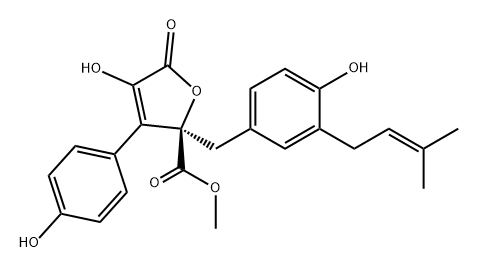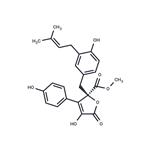Uses
Butyrolactone I is one of a family of three butyrolactones isolated from Aspergillus fumigatus, first reported in 1983. Butyrolactone I exhibits antitumor activity, inhibiting the cell cycle at the G1/S and G2/M transitions. Butyrolactone I is a selective inhibitor of cyclin-dependent kinases CDK1/cyclin B, CDK2 and CDK5, and is an important bioprobe for understanding the cellular roles of CDKs.
Biological Activity
Cell permeable: yes', 'Primary Target
p34cdk1/cyclinB', 'Product does not compete with ATP.', 'Reversible: no', 'Target IC50: 680 nM against Cdk1
Enzyme inhibitor
This natural product (FW = 424.45 g/mol), first identified in species of Aspergillus and named systematically as 2,5-dihydro-4-hydroxy 2-([4- hydroxy-3-(3-methyl-2-butenyl)phenyl]methyl)-3-(4-hydroxyphenyl)-5-oxo- 2-furancarboxylic acid methyl ester, competes with ATP in cyclindependent kinase reactions. The IC50 values for these kinases are typically 0.6-1.5 μM. Butyrolactone I also inhibits cell proliferation by the inhibiting pRb phosphorylation in IMR32 cells, causing both G1 and G2 arrest and stimulating apoptosis. Target(s): cyclin-dependent kinases 1 and 2; cdk5; protein kinase C; protein kinase A; MAP kinase; casein kinase II; [tau protein] kinase.


